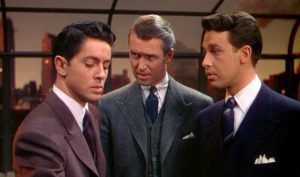
 Over the next two months, Film Forum is showing the complete films of both Alfred Hitchcock and Francois Truffaut. In honor of this pairing, we will preview the Hitchcock films using insights from the directors’ own conversations in Hitchcock/Truffaut, Truffaut’s landmark book of interviews.
Over the next two months, Film Forum is showing the complete films of both Alfred Hitchcock and Francois Truffaut. In honor of this pairing, we will preview the Hitchcock films using insights from the directors’ own conversations in Hitchcock/Truffaut, Truffaut’s landmark book of interviews.
“Rope”, one of the fantastic outliers in Hitchcock’s work, is playing Wednesday at Film Forum. This film was a first for Hitchcock in many respects – his first color film, his first film as an independent producer, but beyond those natural evolutions in his career as a filmmaker, the film is a radical departure from his usual technique.
Adapted from a play, the story is a retelling of the actual Leopold and Loeb case from the 1920s. Two brilliant, rich, young men (John Dall and Farley Granger), eager to apply their Nietzchean Ubermensch theories to real life, strangle a classmate to death. It’s the opposite of a crime of passion; the two men refer to it as an intellectual exercise that they are entitled to because of their superiority. In order to prove that their murder was the perfect crime, the two men put the victim in a large chest, which they then proceed to serve dinner from at a party attended by the victim’s fiancée and family.
Most of the guests are confused by the victim’s absence, but nobody detects anything amiss until Jimmy Stewart arrives. Playing brilliantly against type, Stewart was a mentor to the two young men in school and is the source of some of the killers’ dubious theories of superiority. Stewart horrifies some of the guests with his outré theories, but is even more horrified himself when he begins to suspect that his hosts have actually carried these theories out.
“Rope” was, and still is, shockingly experimental for a big director working with major stars. The film takes place in real time, from 7:30 to 9:15 in a single evening. What’s more, Hitchcock shot the film in as few takes as possible, many up to ten minutes long (the longest length of a film reel in the camera at that time). He even disguises the few cuts that were necessary by having a character cross the foreground as he changes cameras.
This would have been a bold departure for any Hollywood director at the time, but even more so for Hitchcock, whose films are usually a testament to the power of montage and use many more cuts than most films (“The Birds” has 1,630 shots). Hitchcock told Truffaut that he “undertook ‘Rope’ as a stunt… I really don’t know how I came to indulge it.” He admits that the film violates his own rules of telling a story through montage, but that he compensated by “cutting” using “the mobility of the camera and the movement of the players.” In his usual methodical style, Hitchcock mapped out the camera movements precisely before shooting, with tiny numbers marked all over the floor.
Truffaut notes that the film is a gesture towards the “dream of linking all of a film’s components into a single, continuous action,” but both directors agree that in general, the classical editing techniques dating back to Griffith are the best use of the film medium. Hitchcock summarizes the discussion by saying, “No doubt about it; films must be cut.”
Still, “Rope” remains a fascinating experiment and one of the tensest films ever made. There is nothing more squirm-inducing than watching a father listen to inane party conversation while his son lies dead several inches below the hors d’ouvres. “Rope” plays at Film Forum on Wednesday in a double feature with “I Confess,” starring Montgomery Clift.